In my 30-plus years of hunting, I’ve never seen a trend take off like saddle hunting. Maybe it’s just social media amplifying the voices of saddle hunting enthusiasts like myself, but regardless, it’s a trend that shows no signs of slowing down anytime soon.
If you’ve ever considered giving saddle hunting a try but weren’t sure where to start, this article is for you. I’ll cover benefits, essential gear, and tips for safety and success. As I head into my fourth season of saddle hunting, my only regret is not starting sooner.
What Is Saddle Hunting?
If you’ve somehow managed to avoid the online hype, saddle hunting is a method where hunters use a specialized harness, or “saddle,” to position themselves in trees for an elevated vantage point. The saddle is similar to a rock climbing harness but with a fabric seat sewn in for support and comfort.
With traditional tree stand hunting, the hunter typically stands on the platform of the tree stand, or sits on its seat, with their back to the tree, facing out. Saddle hunting flips things around. Saddle hunters face the tree, and a tether rope connects the front of their saddle to the tree. They typically rest their feet on a small platform, much more compact than a traditional tree stand, and lean away from the tree. Sitting is still an option, but you’re simply sitting in your saddle supported by the tether rope, with your knees resting against the tree.
If saddle hunting is completely foreign to you, that description probably sounds confusing, so here is a photo for reference.
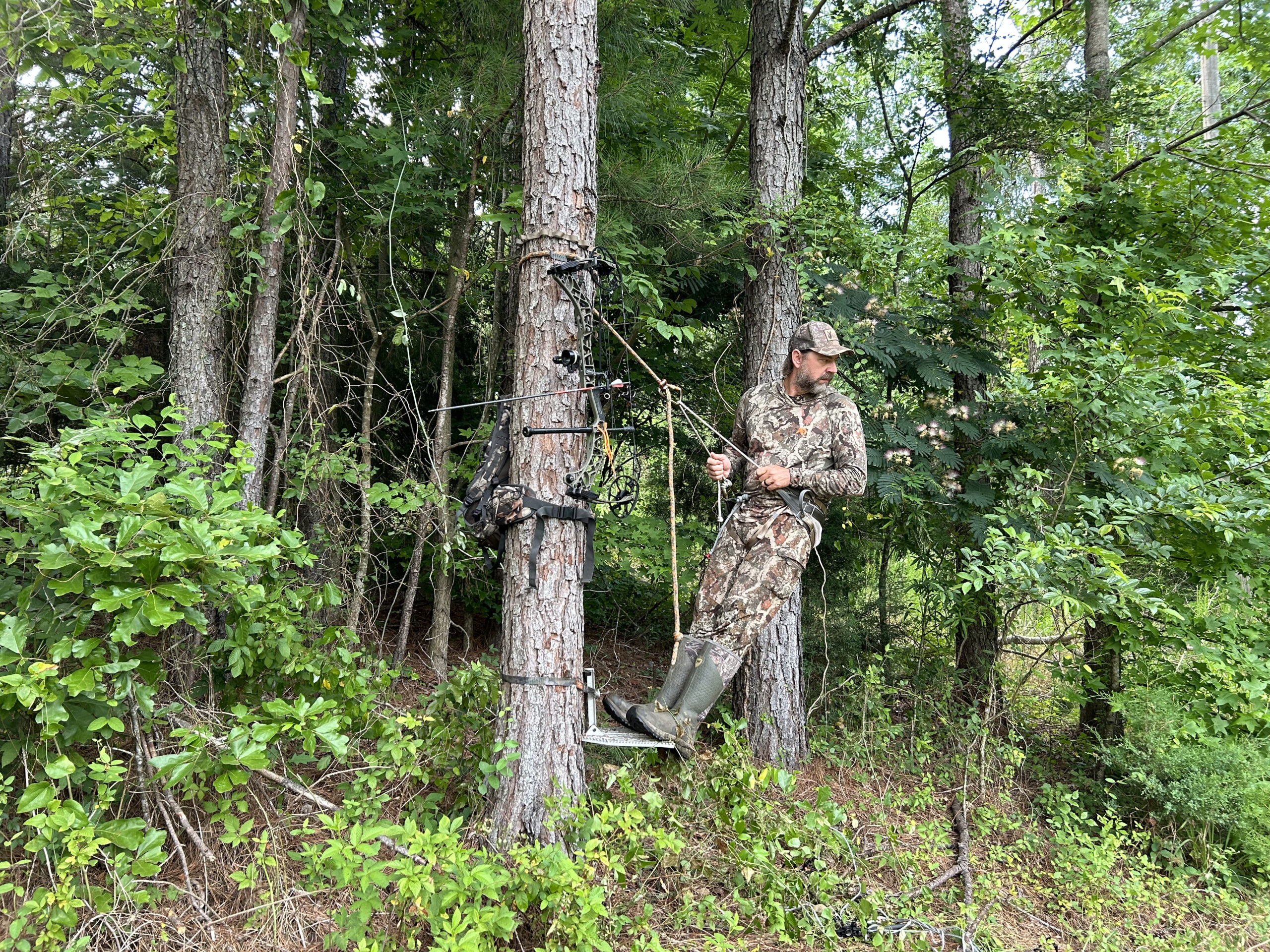
Saddle hunters face the tree, and a tether rope connects the front of their saddle to the tree.
Saddle Hunting Benefits
Like many converts, saddle hunting first piqued my interest with its promise of lighter, more mobile gear, which made trekking deep into public land a more enjoyable experience. But a lighter load isn’t the only benefit.
Saddle hunting can also provide improved concealment by giving you the flexibility to hide behind the tree from approaching deer. Because saddle hunting typically involves facing the tree, with the expectation of the deer coming in from behind the tree, or just off to the side, you can use the tree as a barrier between yourself and the deer for improved concealment.
Unlike a climbing stand, saddle hunting also allows you to climb and hunt almost any tree, regardless of limbs or lean. I always try to use that to my advantage by choosing trees with cover at 10 to 15 feet. That provides even more concealment without the need to get nose-bleed-high in the tree.
And despite how it may look, saddle hunting can be a very comfortable way to hunt. I won’t go as far as saying it’s as comfortable as my Summit Goliath, but I’m much more comfortable in a saddle than in a lock-on or ladder stand. And what I lose in comfort from my climber, I gain back in less weight and increased mobility.
Unlike a climbing stand, saddle hunting also allows you to climb and hunt almost any tree, regardless of limbs or lean.
Essential Saddle Hunting Gear
One of the stumbling blocks for me getting started saddle hunting was confusion over what gear I needed, and what I didn’t. But despite all the gear talk online, you really only need a few things to get up and running.
Saddle Hunting Kit
First and foremost, you’ll need a hunting saddle kit. While you could piece it together yourself, I recommend starting with the kit, because it will include your saddle, lineman and tether ropes, and necessary carabiners.
From there, you’ll just need a platform to rest your feet and stand on, and some way to climb the tree. There are a few different climbing options, from screw-in steps to climbing spurs, but I recommend climbing sticks for the new saddle hunter. They are the simplest and safest way to get to hunting height.
The final essential is some type of pack to carry your gear in. There are plenty of great options on the market depending on what gear you ultimately choose, and how much you pack in on a regular basis.
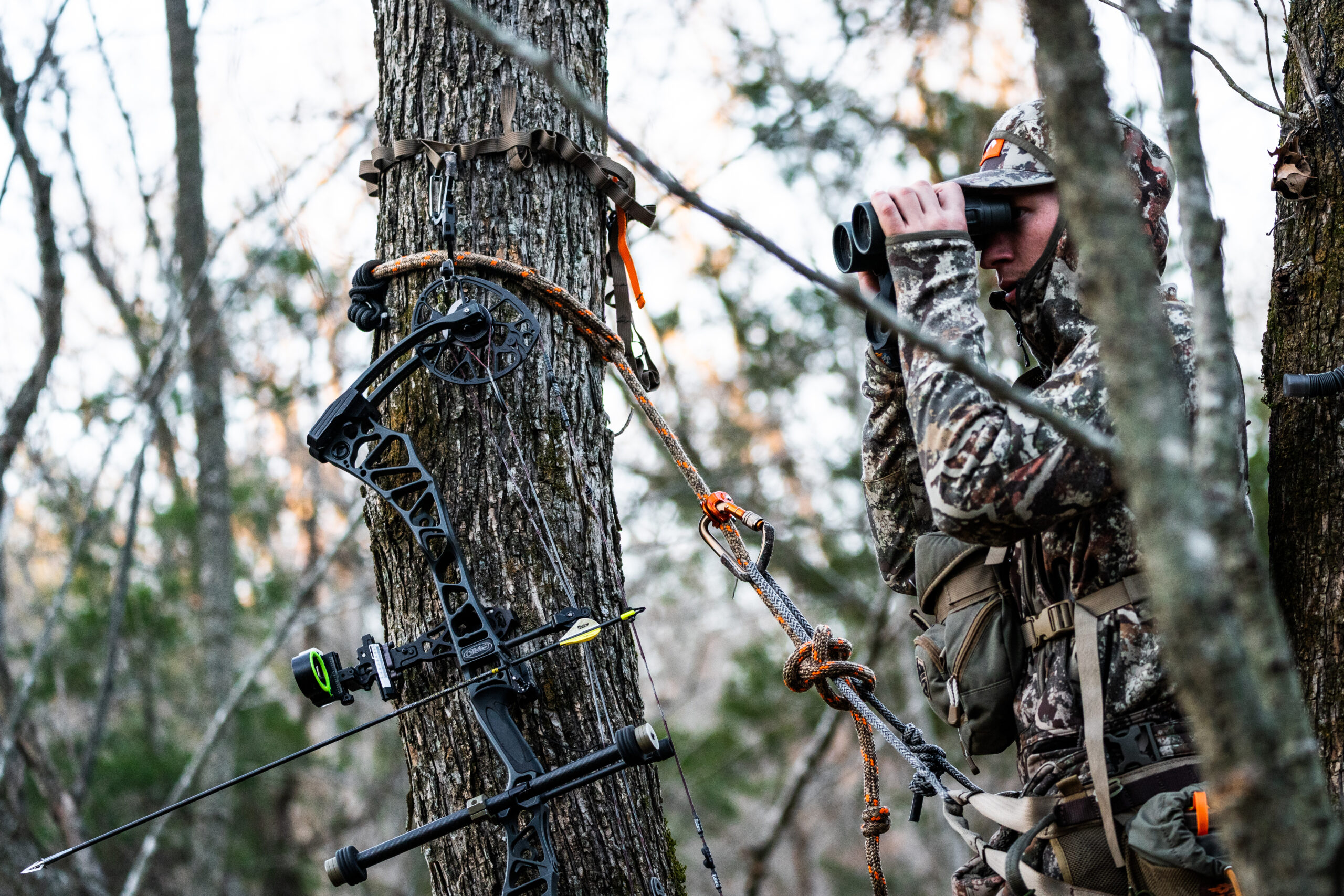
Saddle Hunting Accessories
Beyond the essentials, there are a few accessories I’d recommend to keep you comfortable and organized while in the tree.
Knee Pads
You’ll likely want some knee pads or a knee cushion to protect your knees while resting in the sitting position. Otherwise, you will likely get very uncomfortable very quickly. Unless you plan to lean the whole time, this is a must.
Back Band
A back band is an adjustable strap that attaches to the carabiner of your tether rope and loops around your body, typically just under your arms. It provides support for your back as you lean away from the tree.
If you choose a single-panel saddle, then I highly recommend getting a back band from the start. If you go with a two-panel saddle, like the Latitude Method 2 I used all last season, you may be able to get by without one.
Gear Strap
You’ll also want some type of gear strap to put in the tree to keep all your gear organized and easily accessible—from your bow and your rangefinder, to your grunt call and hunting pack. Gear straps are relatively inexpensive and worth their weight in gold.
You’ll also want some type of gear strap to put in the tree to keep all your gear organized and easily accessible.
There are plenty of other saddle hunting accessories on the market, but the ones discussed above should get you started. As you gain more experience, you may want to add (or remove) some based on what you learn.
Finding the Right Saddle Hunting Gear
I wish I could give you a list of the “best” gear to buy to get started, but it’s not that simple. It would be like me telling you the best car to buy without knowing anything about you. What works best for me (more on that in a bit), may not work for you.
Also, unfortunately, figuring out what gear works best for you isn’t as simple as heading to your local big-box outdoor store to try out the latest saddle hunting gear (most saddle hunting gear is sold direct-to-consumer for now). I think, in time, we’ll see more saddle hunting gear available in retail stores, but for now, you’ll have to take a different approach.
When looking for the right saddle, platform, and climbing sticks, take your time and do your research. Getting outfitted for saddle hunting is not a cheap endeavor, so you want to start with gear that suits your needs.
A few options:
- Hit up outdoor expos where some of the key saddle hunting gear manufacturers will have booths. One example is the Mobile Hunters Expo.
- Join some of the many Facebook groups dedicated to saddle hunting.
- Find guys near you willing to meet up to let you try out their gear. I’ve found that many saddle hunters are more than happy to do so.
If you’re looking to shorten the learning curve as fast as possible, here is what has worked for me:
- Tethrd Phantom saddle.
- Tethrd Predator XL platform (I like the additional footroom of the XL).
- Tethrd One climbing sticks.
With a few seasons under my belt, I think my next saddle will be Tethrd’s Ultralock model due to its pleated-panel design that provides the comfort of a two-panel saddle with the simplicity of a single panel. If you’re on more of a budget, look for their GRIT series.
Setting Up Your Saddle Hunting Gear
Once you have your gear in hand, it’s time to put it all together and start figuring out a routine. My recommendation is to take it slow and start by practicing at ground level to get comfortable. No matter how long you’ve been hunting from a tree stand, saddle hunting is a whole different ballgame. It took me a couple of practice sessions to really start trusting my gear and get comfortable in the setup.
Practice Sessions
Find a straight, limbless tree to practice in, and start by setting your platform up a foot or so off the ground, step on the platform, loop your tether around the tree at eye level, and hook the carabiner from the prussic knot of your tether to the bridge rope of your saddle. You’re now hooked in, and it’s safe to start moving around the platform.
Once you’re comfortable in the saddle, start incorporating your bow to get a feel for taking shots from the saddle. Practice from every possible angle, so that when the opportunity arises during deer season, you’ll know exactly how and where to shoot a deer.
Find a straight, limbless tree to practice in, and start by setting your platform up a foot or so off the ground.
Getting Organized
Use your ground-level practice sessions to figure out how you want to organize your gear in the tree. I typically hang my gear strap just above my tether rope, and my bow on the left side of the tree, so it’s within easy reach of my left hand. My rangefinder, binos, and grunt call hang on the strap directly in front of me for easy access. And I hook my backpack on the hanging end of the gear strap, on the right side of the tree, roughly waist high. That way it’s not in my way when taking a shot, but I can still access anything I may need.
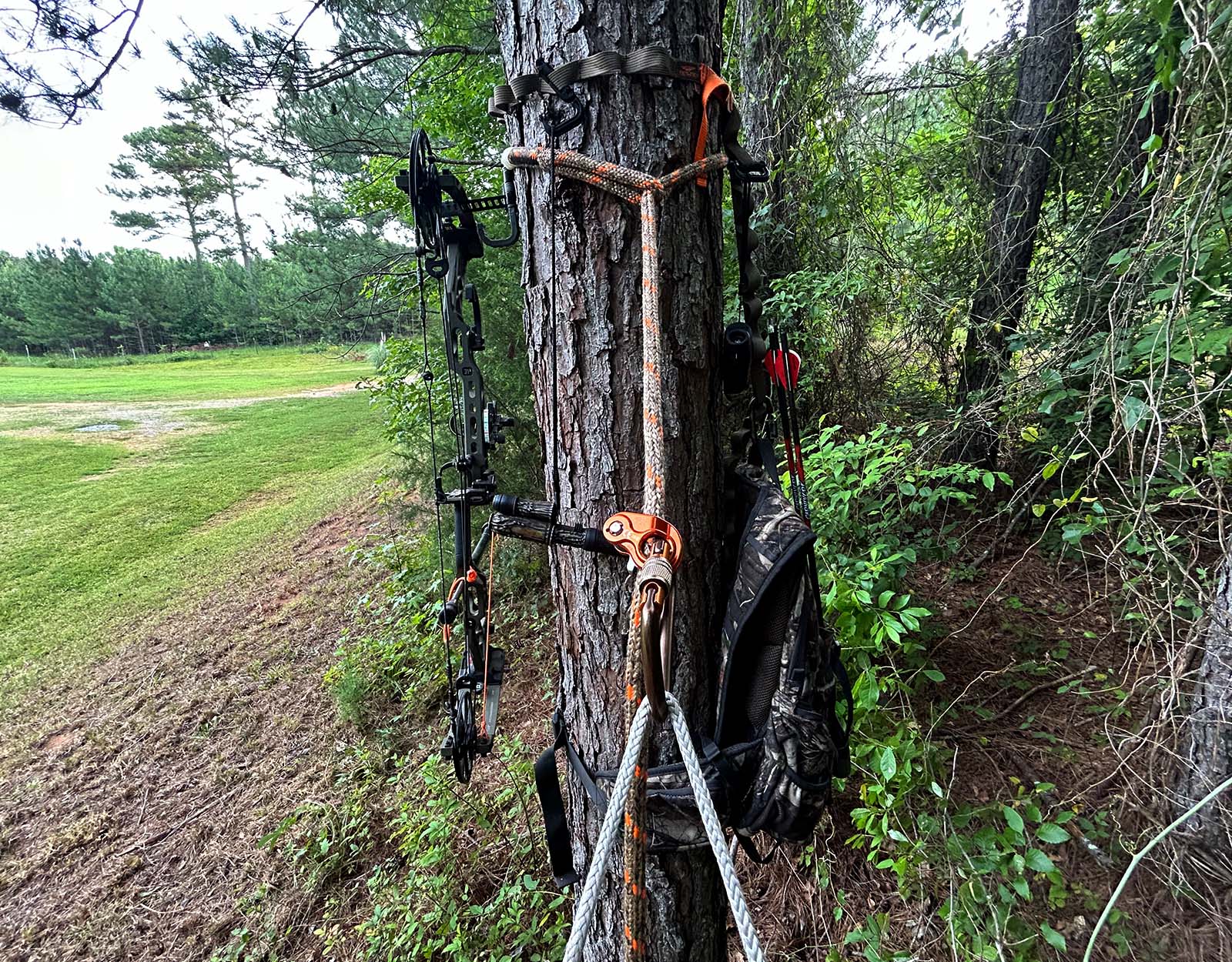
Once you have your setup routine nailed down, you can incorporate your climbing sticks to practice at full hunting height. Make sure you use your lineman’s rope to stay attached to the tree during the entire climbing process, until you are safely tethered in at hunting height.
It will take some time to develop a routine and setup you’re happy with. Three years in, and I am still tweaking my setup on occasion.
Saddle Hunting Techniques and Strategy
Another learning curve for me was figuring out how to best setup in a hunting situation. When possible, you’ll want the tree between you and the direction you think the deer will come from, and you want the deer to pass the tree to your left (if you’re right-handed). That’s completely different than setting up in a traditional deer stand.
Strong Side vs. Weak Side Shots
You’ll often hear saddle hunters refer to strong- or weak-side shots. And with a little practice from the saddle, you’ll quickly understand what they’re referring to. When you’re in your saddle, facing the tree, any shot to your left—say from the 10 o’clock to 6 o’clock position—is relatively easy for a right-handed shooter. That is your strong side. Making a shot on the other side—from the 1 o’clock to 5 o’clock positions—is a little more difficult. That’s your weak side.
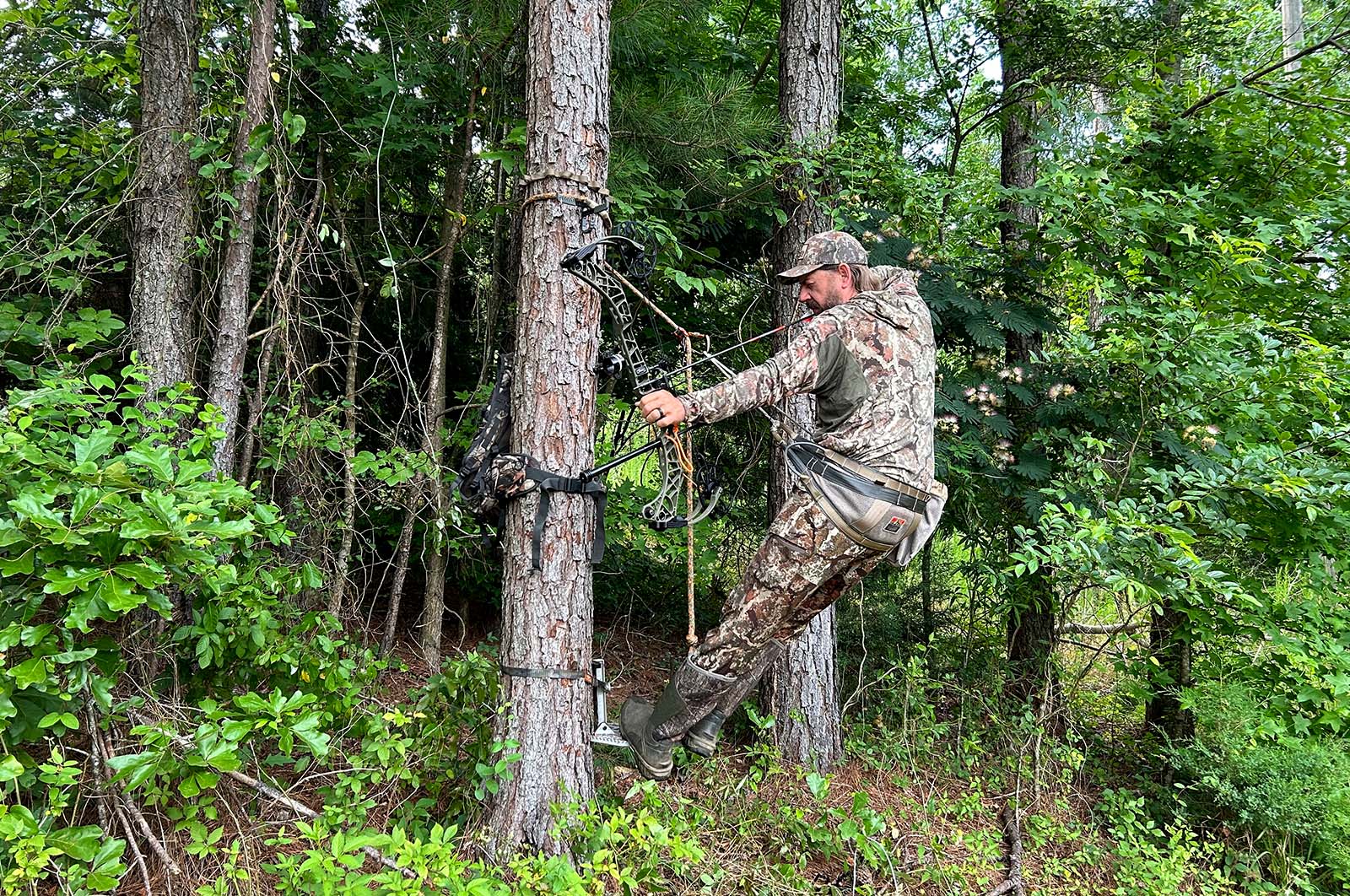
I knew my public land buck from last season required a weak side shot. As is often the case, that buck didn’t follow the script of walking by to my left as I had anticipated. Instead, he broke to my right to freshen a scrape I had overlooked. To make that shot, I had to stand on my platform, rotate 180 degrees so my back was against the tree, and then draw and shoot.
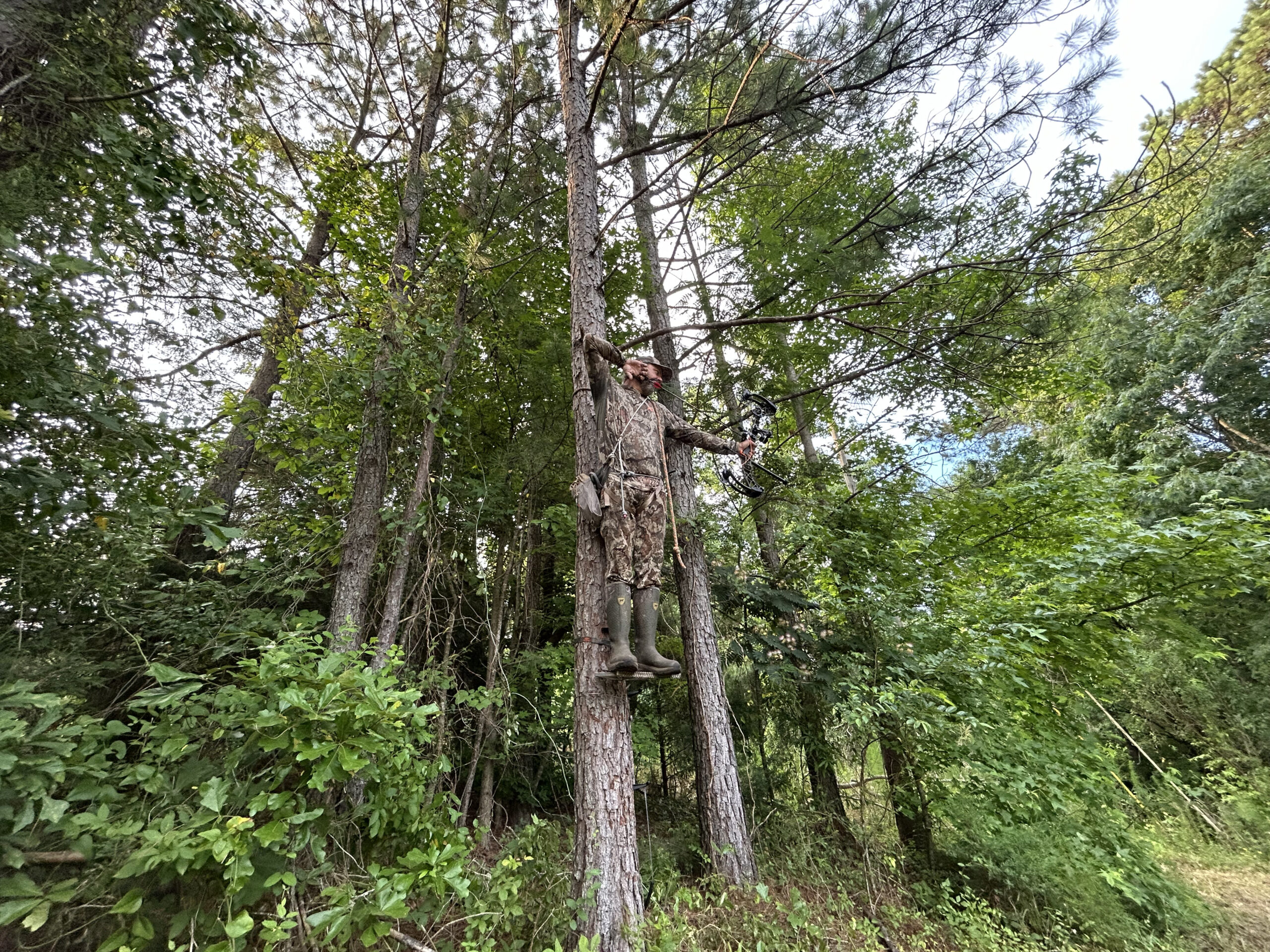
Taking a shot from your weak side is a bit awkward, but it shouldn’t be an issue if you practice taking those shots well in advance of deer season.
When possible, you’ll want the tree between you and the direction you think the deer will come from, and you want the deer to pass the tree to your left (if you’re right-handed).
Safety Considerations
As I mentioned earlier in the article, saddle hunting is as safe as any other style of elevated hunting when you use the proper technique and equipment. But it still has its risks.
Since your saddle and your ropes are the only things separating you from the hard ground, you’ll want to monitor their condition each and every hunt. If you see any signs of wear on the saddle, as far as loose or torn stitching, fraying, or anything that gives you pause, stop using it. The same goes for your ropes and carabiners.
And the most important thing you can do to stay safe in the saddle is to ensure you’re connected to the tree 100% of the time, from the moment you leave the ground until you come back down at the end of the hunt.
Finally, no matter what style of hunting you’re doing, let someone know where you will be and when you’ll be back. That way, if something happens, you won’t be left lying there for hours because no one knows where you are.
Learning Resources for Saddle Hunting
There are a lot of resources online for saddle hunters and would-be saddle hunters, including websites like my personal site, Mobile Deer Hunter. There are also large forums, like the SaddleHunter.com community, as well as plenty of Facebook groups dedicated to this hunting style.
If you’re more of a visual learner, there is no shortage of YouTube channels dedicated, at least in part, to saddle hunting.
Final Thoughts
If you’ve ever considered saddle hunting, I would highly encourage you to give it a try. It’s not for everyone, or every situation, but it’s a great tool to have in your overall deer hunting toolbox. Not only will it lighten your load and make you a more mobile hunter, but it’s safe, comfortable, and just a fun way to hunt.
Elevate Your Hunting Season
Everything you need for whitetail season. Activate your free trial today.